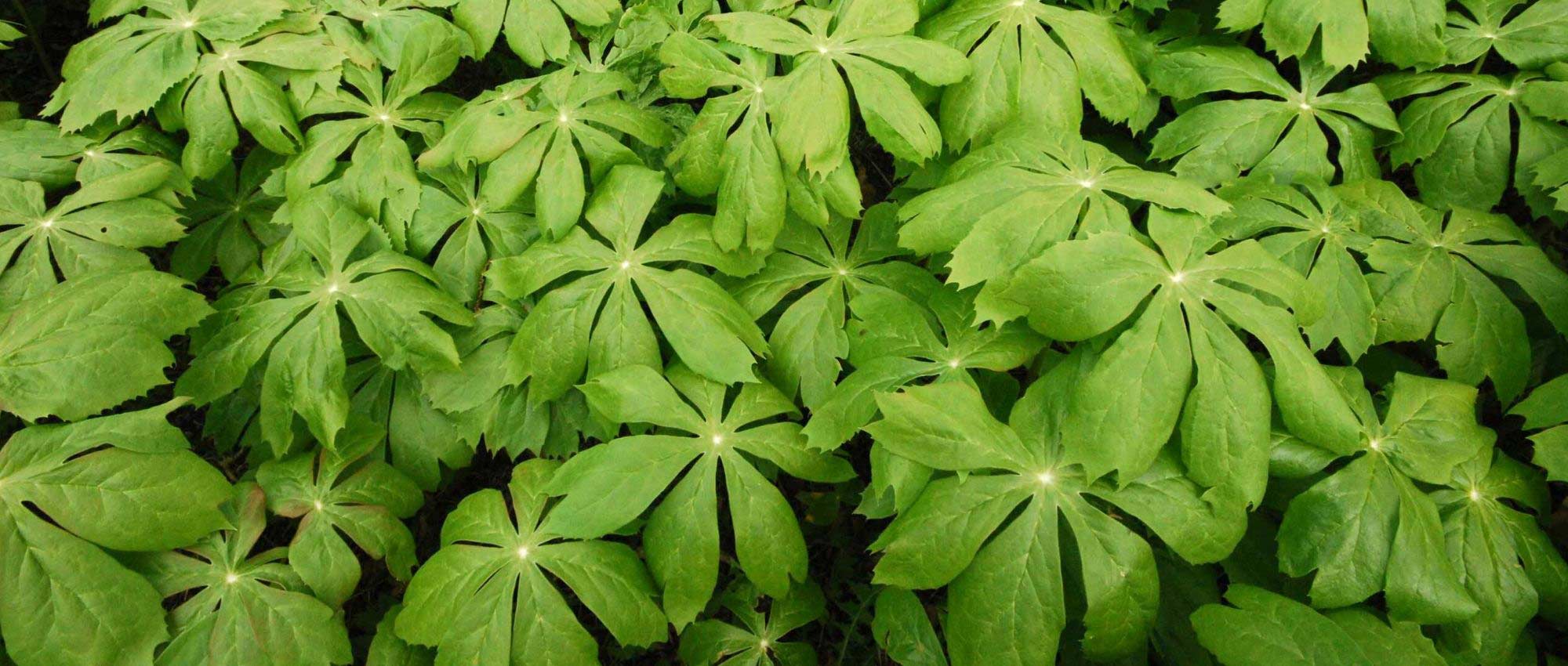
Podophyllum: planting, growing, and caring for
Contents
Podophyllum in a nutshell
- Podophyllum offers surprising foliage, often marked with dark green, brown, or purple spots
- It is a hardy perennial for shade, ideal for forming a groundcover in woodlands
- In spring, it produces a lovely flowering, followed by oval fruits that are green, yellow, or red
- This is a rare and original plant, too little cultivated
- Despite its exotic appearance, it is a very hardy plant!
A word from our Expert
Podophyllum is a curious perennial woodland plant that makes an excellent groundcover with its spectacular foliage! Its leaves take on an umbrella or parasol shape, with a more or less lobed lamina. Some varieties, such as Podophyllum ‘Spotty Dotty’, are particularly unique with their spotted leaves featuring brown or purple markings! Podophyllum offers a great diversity of colours and patterns. We also appreciate their delicate flowering in spring, with white, pink, or dark red blooms, sometimes a bit hidden by the foliage. The flowers are followed by oval fruits that are light green, yellow, or red.
Podophyllum is still a relatively unknown and undercultivated plant! It is a collector’s plant that deserves to be planted more often in gardens. Its only drawback is that it takes a long time to establish. If you want an immediate effect, look elsewhere… But it is worth being patient to enjoy it: once established, it requires little attention, spreads gradually, and has a long lifespan! It will thrive in a naturalistic garden, in woodland, where it can form large colonies over time. Moreover, despite its exotic appearance, Podophyllum is a completely hardy plant, tolerating temperatures down to -15, or even -20 °C.
Botany
Botanical data
- Latin name Podophyllum sp.
- Family Berberidaceae
- Common name Podophyllum, May apple
- Flowering May-June
- Height up to 50 cm
- Exposure shade, partial shade
- Soil type rich, humus-bearing, cool and draining
- Hardiness between -15 and -20 °C
Podophyllum is a rhizomatous perennial that forms colonies in woodlands. It is valued for its unique foliage, often beautifully coloured. The Podophyllum peltatum is native to the United States and Canada, where it grows in deciduous forests, sometimes at the edge of woodlands and along riverbanks. Other species are mainly found in Asia (China, Taiwan, India…), where they thrive in high-altitude forests, which likely explains their good hardiness.
Podophyllum exhibits a great variability in leaf shapes and colours, even within a single species, depending on the clone and age of the plant. The Podophyllum delavayi has given rise to several surprising varieties with beautifully marbled leaves, such as the varieties ‘Spotty Dotty’ or ‘Kaleidoscope’.
Generally, nine species of Podophyllum are recognised; however, recent classifications acknowledge only one: Podophyllum peltatum, with the other species reclassified into the genera Dysosma and Sinopodophyllum.
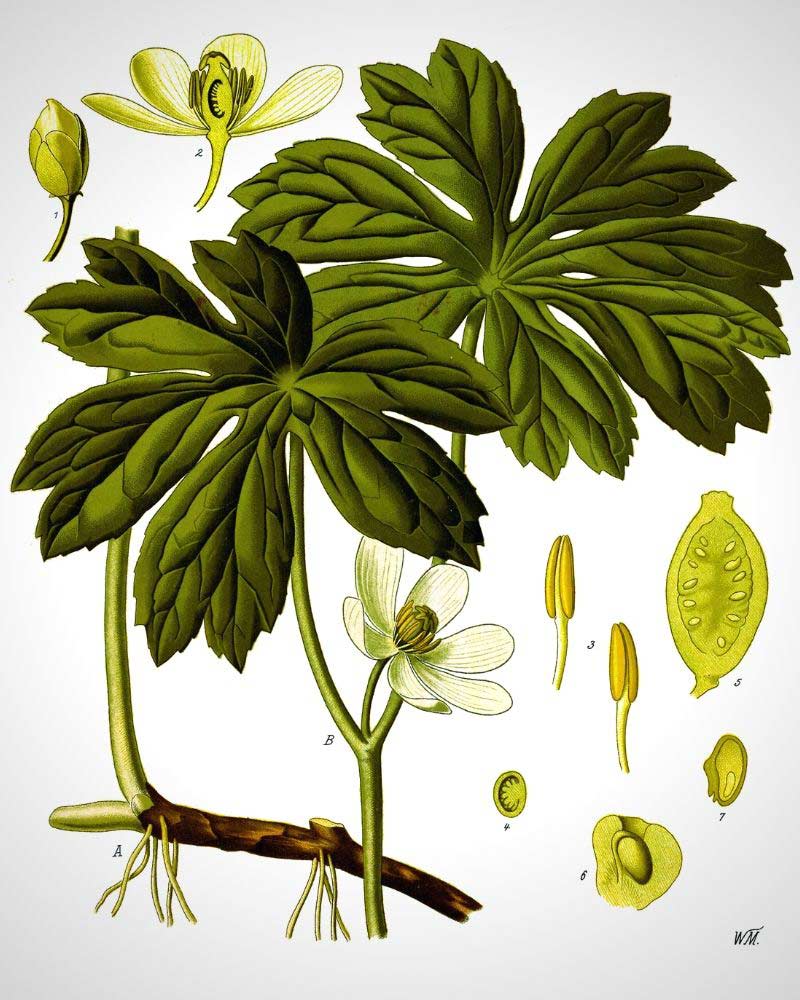
Podophyllum peltatum: Botanical illustration
The name Podophyllum comes from the Greek podos: foot, and phyllon: leaf, referring to the shape of the leaves of certain species, resembling footprints. Podophyllum is sometimes nicknamed “May apple” (in English, may apple) due to its decorative fruits.
Podophyllum belongs to the family Berberidaceae. This is the family of Berberis, which also includes other ornamental plants such as Epimedium, Mahonia, and Nandina.
While Podophyllum is indeed a plant that takes time to establish, growing slowly, it has great longevity! It gradually spreads to form a lovely groundcover, somewhat like Rodgersia. In fact, the species Rodgersia podophylla was named in reference to Podophyllum!
Podophyllum spreads through its running and ramified rhizomes, which are shallow. From the soil emerge very straight stems, topped with leaves, in an umbrella shape, reaching a height of 40 to 50 cm.
In spring, when they appear, Podophyllum somewhat resembles a colony of mushrooms, with thick, very straight stems emerging directly from the ground, crowned by the folded leaf, which resembles a hat. This is particularly noticeable in Podophyllum peltatum: at the beginning of the season, its foliage is brown and folded, then it unfurls into an umbrella shape and takes on a beautiful green hue!
Podophyllum is remarkable for its unique foliage! Some varieties have a somewhat monstrous appearance, with their irregular purplish-brown spots, like Podophyllum ‘Spotty Dotty’ or Podophyllum difforme. The leaves of Podophyllum are large and palmate, measuring between 15 and 35 cm in diameter, and consist of five to nine lobes. Each stem bears only one or two leaves, in an umbrella shape. Those of Podophyllum peltatum are deeply lobed, while those of Podophyllum pleianthum are more entire, in a hexagon or star shape. Their shape somewhat resembles that of lady’s mantle.
Don’t worry if you see the foliage drying up and disappearing in summer! The plant adapts to drought in this way, entering dormancy to conserve its energy, and will not reappear until the following spring!

The unique foliage of Podophyllum! Here, Podophyllum peltatum (photos: Andrew Cannizzaro / Katja Schulz), and Podophyllum ‘Spotty Dotty’ (photo peganum)
The flowering of Podophyllum is discreet, very humble! It appears in spring, in May-June, on plants at least three years old. Except for the Podophyllum hexandrum, in other species the flowers hide beneath the foliage! They are inserted close to the stem, at the junction between the leaves. They can be solitary or grouped in clusters, as seen in Podophyllum pleianthum. The flowers are cup-shaped, measuring 4 to 5 cm in diameter, and consist of six to nine petals, surrounded by six sepals. Generally, at the heart of the flower, there are about a dozen stamens, sometimes up to 20.
The Podophyllum peltatum and P. hexandrum offer lovely white flowers, very elegant! They are well opened, revealing the yellow stamens at the centre. Those of Podophyllum delavayi and P. pleianthum are much more surprising, with elongated, drooping petals of a dark red colour.
After flowering, Podophyllum produces surprising ovoid fruits (another curiosity of this plant!), which can be red, light green, or yellow. They earn it the nickname May apple (mayapple) – although they appear in summer and not in May! These fruits measure 4 to 5 cm long and contain seeds. In nature, they are consumed by wild animals (small mammals, birds…), which thus disperse the seeds.

The flowers of Podophyllum hexandrum (photo Meneerke bloem) and Podophyllum ‘Spotty Dotty’, and the red fruits of P. hexandrum (photo Andy king50)
The main varieties of Podophyllum
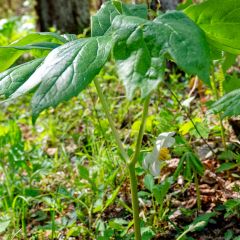
Podophyllum peltatum
- Flowering time June, July
- Height at maturity 40 cm
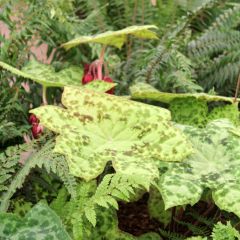
Podophyllum Spotty Dotty
- Flowering time June, July
- Height at maturity 40 cm
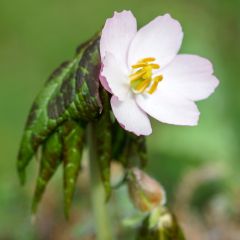
Podophyllum hexandrum
- Flowering time June, July
- Height at maturity 50 cm
Discover other Podophyllum
View all →Available in 1 sizes
Available in 3 sizes

Available in 1 sizes
Available in 1 sizes
Available in 1 sizes
Planting
Where to Plant?
As Podophyllum does not like to be moved, it is important to choose its location carefully! It is a woodland plant, which thrives in shade, whether dense or partial. Direct sunlight may scorch the foliage or make it duller, while in the shade, the leaves stand out much better. Additionally, Podophyllum peltatum copes very well with root competition. It can easily be planted at the base of trees and bushes!
Most Podophyllums prefer rich, organic, humus-bearing soils. Podophyllum peltatum tolerates dry shade, while Asian species prefer cool soils and adapt well to planting at the edge of a pond. If the soil is rich, Podophyllum will produce impressive foliage, whereas in poor soil, the leaves will be smaller. Under good growing conditions, Podophyllum can self-seed and naturalise. Regarding pH, Podophyllum prefers acidic or neutral soils.
Avoid planting it at the edge or in a border, as the leaves may dry out in the middle of summer, leaving you with a difficult gap to fill. It is better to plant Podophyllum in woodland, where it can form a generous groundcover. It is perfect in a natural area of the garden, where intervention is minimal.
When to Plant?
Plant Podophyllum in spring, around April, or in autumn, between September and November.
How to Plant?
As Podophyllum grows slowly, you will achieve a better effect by planting several young plants at the same time, rather than planting it in isolation.
- Dig a planting hole that is at least twice the size of the root ball.
- Add well-decomposed compost to enrich the soil.
- Remove the Podophyllum from its pot and place it in the planting hole.
- Replace the soil around it and lightly firm it down.
- Water generously.
- Feel free to apply a mulch, such as dead leaves, linseed flakes, or RCW (ramial chipped wood).
Continue to water regularly in the weeks following planting.
It is possible to plant Podophyllum in a pot; however, it will thrive much better in open ground.
Podophyllums take a long time to establish and develop. Do not despair if your Podophyllum produces only one leaf in the first year; this is perfectly normal! You can, however, plant several young plants together to achieve a bushier effect more quickly. You will also need to wait three to four years before your Podophyllums start to flower!
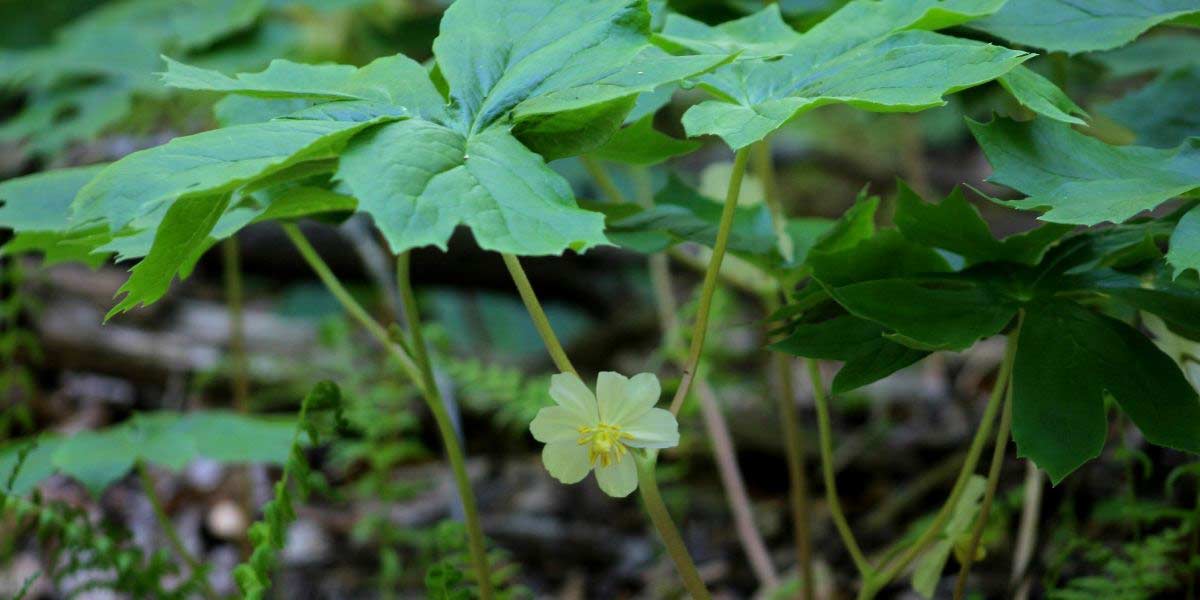
Podophyllum peltatum (photo Anthony Sokolik)
Entretien
In the first year, especially in spring and summer, ensure that the soil remains moist. Water during dry spells, preferably with rainwater rather than tap water. From mid-summer, when the plant begins to enter dormancy, it is better for the soil to be on the drier side to prevent the roots from rotting.
We recommend adding some well-decomposed compost each year to enrich the soil, and occasionally renewing the mulch. Use fallen leaves or RCW, applying it in a few centimetres thick layer.
As Podophyllum take a long time to establish, it is best not to transplant or move them during the growing season, as this may disrupt their development!
Podophyllum are frequently attacked by slugs, which particularly enjoy the young tender leaves in spring. You can place eggshells or ash around your plants as a barrier, or even create a slug trap. If you would like more information on natural techniques to combat slugs, please consult our dedicated advice sheet.
Multiplication
The best technique for multiplying Podophyllum is division! However, you should wait until the plant is at least 6 or 7 years old. It is possible to sow the seeds after harvesting the fruits, but this method takes longer and yields unpredictable results. Moreover, if you are cultivating a horticultural variety, sowing may produce a young plant different from the parent plant.
Division of the rootstocks
The ideal time to divide Podophyllum is late summer, around September.
- Choose a well-established and large clump that has been in place for at least six years.
- Dig up the rootstock by excavating quite widely.
- Cut the rootstock into several sections, each should have at least one bud. You can leave part of it in place so that the Podophyllum can regrow in the same spot, and move the others.
- Prepare the soil and replant the fragments of rootstock.
- Water generously.
Association
Pair Podophyllum with other woodland plants to create a very natural scene. We particularly recommend P. peltatum, with its delicate green foliage, which also has the advantage of tolerating root competition very well, beautifully dressing the base of trees and bushes. You can plant it alongside ferns, brunnera, Solomon’s Seal, corydalis, or hostas. Also discover Kirengeshoma, a perennial with generous foliage and delicate yellow flowers. Enjoy the extremely light foliage of Mahonia ‘Soft Caress’, whose narrow leaflets will contrast beautifully with the large leaves of Podophyllum!
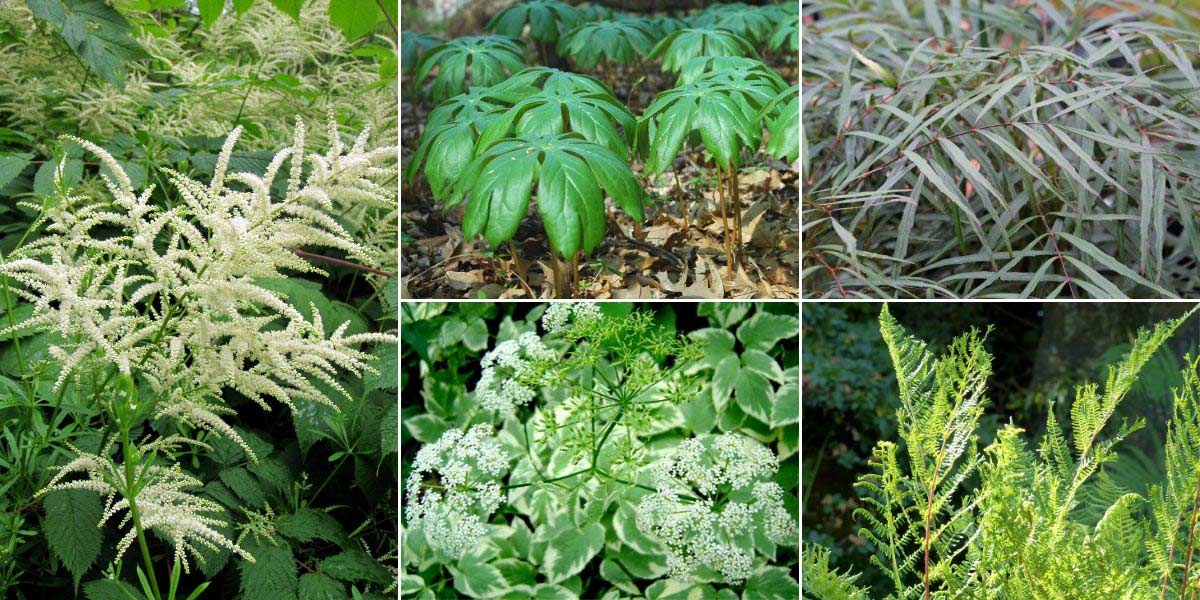
Integrate Podophyllum into a naturalistic woodland garden. Aruncus dioicus, Podophyllum peltatum (photo Valis55), Mahonia ‘Soft Caress’, Aegopodium podagraria ‘Variegata’, and Athyrium filix-femina ‘Lady in Red’
Incorporate blooms that will bring brightness to the woodland. We particularly recommend Astilbes, Ligularias, and Asian Primroses… Aruncus dioicus, or Goat’s Beard, is also interesting for its white, feathery flowers, which will add a lot of light to a shaded area. Also enjoy the delicate white umbels of Aegopodium podagraria!
You can pair Podophyllum ‘Spotty Dotty’ with other unique foliage. Consider heucheras and hostas, the ferns Coniogramme emeiensis and Athyrium filix-femina ‘Frizelliae’, as well as Farfugium japonicum ‘Crispata’, which has large, undulating leaves along the edge of the lamina… Moreover, these unique plants will enhance the exotic and lush aspect brought by Podophyllum! Don’t hesitate to create a garden corner with botanical curiosities, uncommon plants that surprise with their foliage or flowers! For example, you can enjoy Arisaema, appreciated for their curious flowers that resemble a snake’s head, as well as their graphic and finely cut foliage.
Useful resources
- Discover our range of Podophyllum
- To pair with Podophyllum, our range of woodland plants
- Our advice sheet “Creating a shady border: Which plants to choose?”
Frequently asked questions
-
Why aren't my Podophyllums flowering?
Be patient, they are probably too young. You need to wait at least three years before they start flowering! Also, remember that the flowering is subtle, often a bit hidden by the foliage. If you want to enjoy flowers that are clearly visible, positioned above the leaves, we recommend growing Podophyllum hexandrum.
-
Can I move the Podophyllum?
As far as possible, it is better to avoid it, as it is a plant that does not like to be transplanted. Of course, if the conditions are unfavourable (sun, overly dry soil...), you can move it, preferably at the end of summer – beginning of autumn, and by digging wide enough not to disturb its root system too much. Then, be patient: it will take some time to adapt to its new location.
-
The leaves of my Podophyllum are holey and appear to be chewed!
The culprits are likely the slugs: they enjoy the young leaves of Podophyllum. To keep them away, you can place ash or sand around your young plants, or create a slug trap.
-
Why is the foliage drying out?
If this occurs in the middle of summer, don't worry, it's perfectly normal! The plant enters dormancy and will reappear the following spring. If this happens in spring or early summer, check that the conditions are suitable: Podophyllum needs to be in the shade, it doesn't like direct sunlight, and the soil should remain relatively cool during the growth period (feel free to water).
- Subscribe!
- Contents
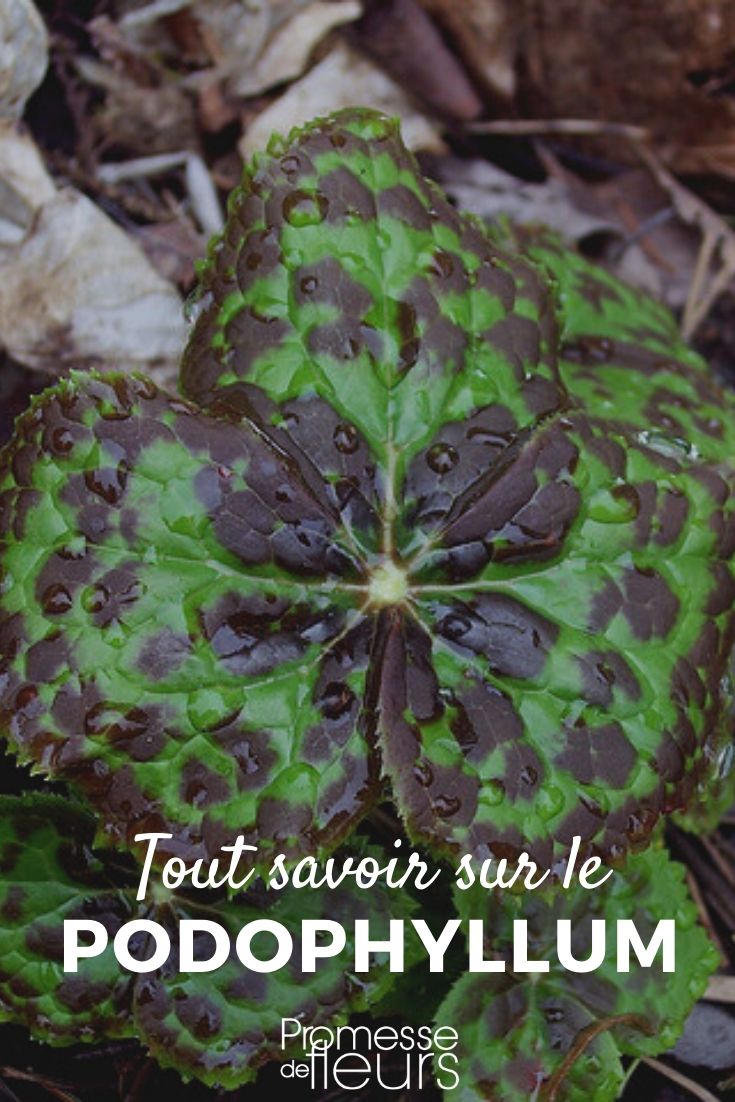

































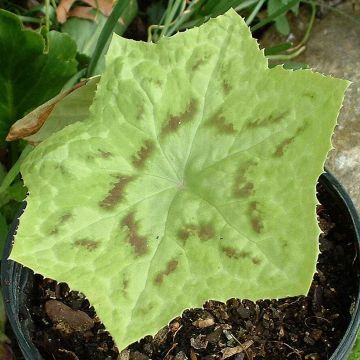
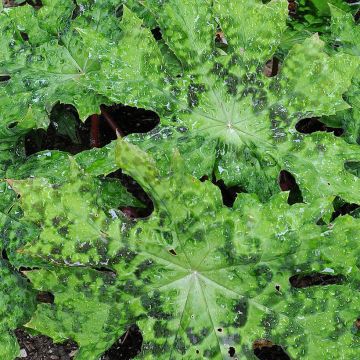
Comments